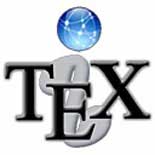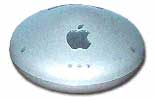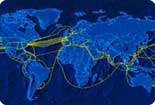 If you are
If you are
a mathematician, you’d better have a functioning TeX on your computer
which I do not have at the moment as I completely erased my HD yesterday
and started brand new. Some time ago this would make me slightly nervous
but as I did install TeX on a number of computers recently I hope to get
it up and running in no time. However, as the install process changes
slighly each time I’ll log here my actions for future reference.
Further this log may convince you to buy a Macintosh because I really do
not know of a better TeX system around.
A good source
for TeX material is the PennState Mac-TeX page. The
first thing to do is to get a good editor such as the freeware BBedit
Lite but the present link directs to the commercial version so has this
Lite version been taken off the net? Fortunately not, a quick
Google tells me that BareBones still maintain a BBedit Lite page from which you can get the 6.1.2
version (it contains a version for OS X and one running under System 9),
so copy the BBedit Folder to the ApplicationFolder and the OSX program
to the Dock.
Next, we will need a spelling checker
like Excalibur which you can find under the
Tools/Utilities of the PennState-site. So download from the links
: Excalibur 4.0 (782k), the Mathematical Lexicon (29k) and the Dutch
dictionary (791k), put these two Folders (or any other Dictionaries you
like to download) in the ExcaliburFolder and copy this to the
ApplicationsFolder and Excalibur itself to the Dock. These matters
settled, it is now time for the big gun : TeX itself.
You can get there from the Engines subsection of the
PennSate site but it’s better to go directly to the excellent TeX on Mac OS X page and follow the instructions (which as I mentioned before tend
to change slightly). I used to get the iInstaller first and
install then the required packages but this time I’ll go for the quick
and dirty route : I’ll get myself the TeX-fat.dmg disk image
(77Mb) which contains TeX and Ghostscript 8 and the i-Installer!
What you obtain is a Volume with the i-Installer, a i-Packages
Folder, some files to read and the TeX-fat.iid. Take the
i-Installer to the Applications/Utilities Folder and to the Dock.
Drag the TeX-fat.iid file on the mounted volume on the i-Installer
application icon. You will be presented with an i-Directory with two
packages on the volume. Install all of them. It is best to install
ghostscript after you have installed TeX as it may contain configuration
material that can take advantage of TeX. I got a warning message but
choose to ignore it, seems to install as expected. Along the way you are
asked a few simple questions (such as paper size, formats you want to
have etc.) when in doubt go for the default! Okay : Task finished! But I
still have to install the ghostscript 8 package but this goes a lot
faster. So we should now have a working TeX installation but are still
missing a front-end. These you can download fllowing the links at
the beginning of the TeX on Mac OS X page. I usually go for TeXShop which is a 3.1Mb disk-image download. Drag
TeXShop into the ApplicationsFolder and the Dock. Find the file named
“pdfsync.sty” in the distribution directory. Drag a copy of this file
to ~/Library/texmf/tex/latex. Here ~/Library is the Library folder in
your home directory. You may need to create the folders texmf, tex, and
latex if they do not already exist. Alternatively, you can gp for iTeXMac (I never figured out what went wrong
between these two developers, but surely it was something
big).
At a later stage I am sure I want to add
new style files from CTAN. So here is the drill : copy them in the
diectory
/usr/local/teTeX/share/texmf.local/tex/latex/…
and do a texhash from the command line (as root).
I noticed that lately one do no longer need to adjust parameters to get
a heavy xy-pic file being compiled but if one does not to change any of
the values : be root and go to
/usr/local/teTeX/share/texmf/web2c/texmf.cnf
increase values and do a texhash. Finally, if you want to
print chess or go-diagrams or other fancy pictures requiring
metafont files here is the drill : be root and copy the .mf files
in an apropriate directory under
/usr/local/teTeX/share/texmf/fonts/source/public/
(if necessary change the owner of the directory) and
then do a texhash.

 Did you ever wonder what hardware keeps the web running ?
Did you ever wonder what hardware keeps the web running ? If you are
If you are